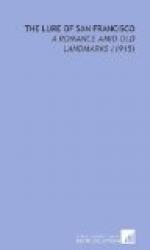He stooped to get a full look at my eyes. “I never knew a Spaniard to have eyes the color of violets. Look up your family tree, my dear enthusiast, and I think you will find that you are we.”
“I’m not,” I declared indignantly. “I’m a Californian. I was born here and even if I haven’t Spanish blood in my veins, I have the spirit of the old padres.”
“But the spirit has not left a lasting impression. Indeed civilization whether dealt out with friendly hands or thrust upon the natives at the point of the bayonet seems to have been equally poisonous on both sides of the continent.”
“True, philosopher, but would you call the work of these padres impressionless, when it has permeated all California? The open-hearted hospitality of the Spaniards is a canonical law throughout the West, and their exuberant spirit of festivity still remains, impelling us to celebrate every possible event, present and commemorative.”
We had reached Dolores Street, a broad parked avenue where automobiles rushed by one another, shrieking a warning to the pedestrian. Suddenly I found myself alone. My companion had darted across the crowded street to a little oasis of grass where a mission bell hung suspended on an iron standard.
“It marks ‘El Camino Real,’” he reported as he rejoined me.
“The King’s Highway,” I translated. “It must have been wonderful at this season of the year, for as the padres traveled northward, they scattered seeds of yellow mustard and in the spring a golden chain connected the missions from San Francisco to San Diego. Over there nearer the bay,” I nodded toward the east where a heavy cloud of black smoke proclaimed the manufacturing section of the city, “lay the Potrero—the pasture-land of the padres—and the name still clings to the district. Beyond was Mission Cove, now filled in and covered with store-houses, but formerly a convenient landing place for the goods of Yankee skippers who, contrary to Spanish law, surreptitiously traded with the padres.”
We turned to the massive facade of the old church, where hung the three bells, of which Bret Harte wrote.
“Bells of the past, whose
long forgotten music
Still fills the
wide expanse;
Tingeing the sober twilight of the
present,
With the color
of romance.”
As we entered the low arched doorway, we seemed to step from the hurry of the twentieth century into the peace of a by-gone era. Outside, the modern structures crowd upon the low adobe building, staring down upon it with unsympathetic eyes and begrudging it the very land it stands on, while inside, hand-hewn rafters, massive grey walls, and a red tiled floor slightly depressed in places by years of service, point mutely to the past, to the days when padres and neophytes knelt at the sound of the Angelus. Within still stand the elaborate altars brought a century ago from Mexico, before which Junipero Serra held mass during his last visit to San Francisco. On the massive archway spanning the building, can be seen the dull red scroll pattern, a relic of Indian work.




